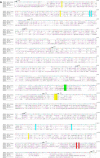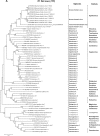Bioinformatics and Molecular Analysis of the Evolutionary Relationship between Bovine Rhinitis A Viruses and Foot-And-Mouth Disease Virus
- PMID: 27081310
- PMCID: PMC4822724
- DOI: 10.4137/BBI.S37223
Bioinformatics and Molecular Analysis of the Evolutionary Relationship between Bovine Rhinitis A Viruses and Foot-And-Mouth Disease Virus
Abstract
Bovine rhinitis viruses (BRVs) cause mild respiratory disease of cattle. In this study, a near full-length genome sequence of a virus named RS3X (formerly classified as bovine rhinovirus type 1), isolated from infected cattle from the UK in the 1960s, was obtained and analyzed. Compared to other closely related Aphthoviruses, major differences were detected in the leader protease (L(pro)), P1, 2B, and 3A proteins. Phylogenetic analysis revealed that RS3X was a member of the species bovine rhinitis A virus (BRAV). Using different codon-based and branch-site selection models for Aphthoviruses, including BRAV RS3X and foot-and-mouth disease virus, we observed no clear evidence for genomic regions undergoing positive selection. However, within each of the BRV species, multiple sites under positive selection were detected. The results also suggest that the probability (determined by Recombination Detection Program) for recombination events between BRVs and other Aphthoviruses, including foot-and-mouth disease virus was not significant. In contrast, within BRVs, the probability of recombination increases. The data reported here provide genetic information to assist in the identification of diagnostic signatures and research tools for BRAV.
Keywords: BRAV RS3X; bioinformatics; evolution; phylogeny; sequence.
Figures








Similar articles
-
Detection and Genomic Characterization of Bovine Rhinitis Virus in China.Animals (Basel). 2023 Jan 16;13(2):312. doi: 10.3390/ani13020312. Animals (Basel). 2023. PMID: 36670851 Free PMC article.
-
Molecular and phylogenetic analyses of bovine rhinovirus type 2 shows it is closely related to foot-and-mouth disease virus.Virology. 2008 Apr 10;373(2):411-25. doi: 10.1016/j.virol.2007.12.019. Epub 2008 Jan 16. Virology. 2008. PMID: 18201745
-
Characterization of a chimeric foot-and-mouth disease virus bearing a bovine rhinitis B virus leader proteinase.Virology. 2013 Dec;447(1-2):172-80. doi: 10.1016/j.virol.2013.08.035. Epub 2013 Oct 1. Virology. 2013. PMID: 24210112
-
Foot-and-Mouth Disease Virus Leader Protease Cleaves G3BP1 and G3BP2 and Inhibits Stress Granule Formation.J Virol. 2019 Jan 4;93(2):e00922-18. doi: 10.1128/JVI.00922-18. Print 2019 Jan 15. J Virol. 2019. PMID: 30404792 Free PMC article.
-
Equine picornaviruses: well known but poorly understood.Vet Microbiol. 2013 Nov 29;167(1-2):78-85. doi: 10.1016/j.vetmic.2013.05.012. Epub 2013 Jun 10. Vet Microbiol. 2013. PMID: 23820049 Review.
Cited by
-
Evolutionary conserved compositional structures hidden in genomes of the foot-and-mouth disease virus and of the human rhinovirus.Sci Rep. 2019 Nov 12;9(1):16553. doi: 10.1038/s41598-019-53013-8. Sci Rep. 2019. PMID: 31719605 Free PMC article.
-
Discovery and characterization of BRBV-sheep virus in nasal swabs from domestic sheep in China.Front Cell Infect Microbiol. 2024 Jun 28;14:1380708. doi: 10.3389/fcimb.2024.1380708. eCollection 2024. Front Cell Infect Microbiol. 2024. PMID: 39006745 Free PMC article.
-
Detection and Genomic Characterization of Bovine Rhinitis Virus in China.Animals (Basel). 2023 Jan 16;13(2):312. doi: 10.3390/ani13020312. Animals (Basel). 2023. PMID: 36670851 Free PMC article.
References
-
- Snowder GD, Van Vleck LD, Cundiff LV, Bennett GL, Koohmaraie M, Dikeman ME. Bovine respiratory disease in feedlot cattle: phenotypic, environmental, and genetic correlations with growth, carcass, and longissimus muscle palatability traits. J Anim Sci. 2007;85(8):1885–92. - PubMed
-
- Ellis JA. Update on viral pathogenesis in BRD. Anim Health Res Rev. 2009;10(2):149–53. - PubMed
-
- Glotov AG, Glotova TI, Sergeev AN, Drozdov IG. Pathogenesis of mixed experimental infection caused by diarrheal viruses – bovine mucosal disease and bovine infectious rhinotracheitis in calves. Vopr Virusol. 2007;52(4):40–3. - PubMed
-
- Darbyshire JH, Jennings AR, Omar AR, Dawson PS, Lamont PH. Association of adenoviruses with bovine respiratory diseases. Nature. 1965;208(5007):307–8. - PubMed
LinkOut - more resources
Full Text Sources

